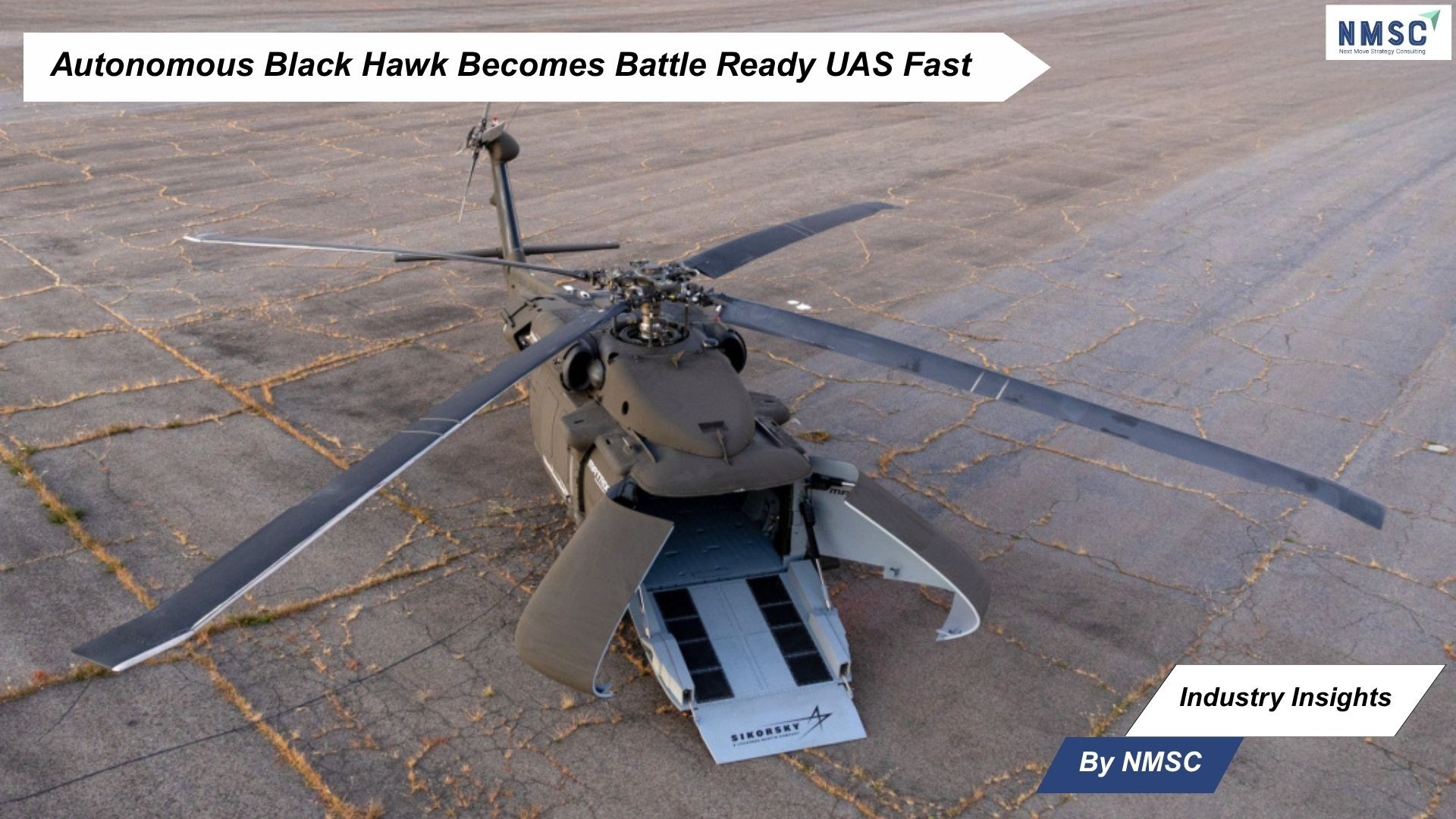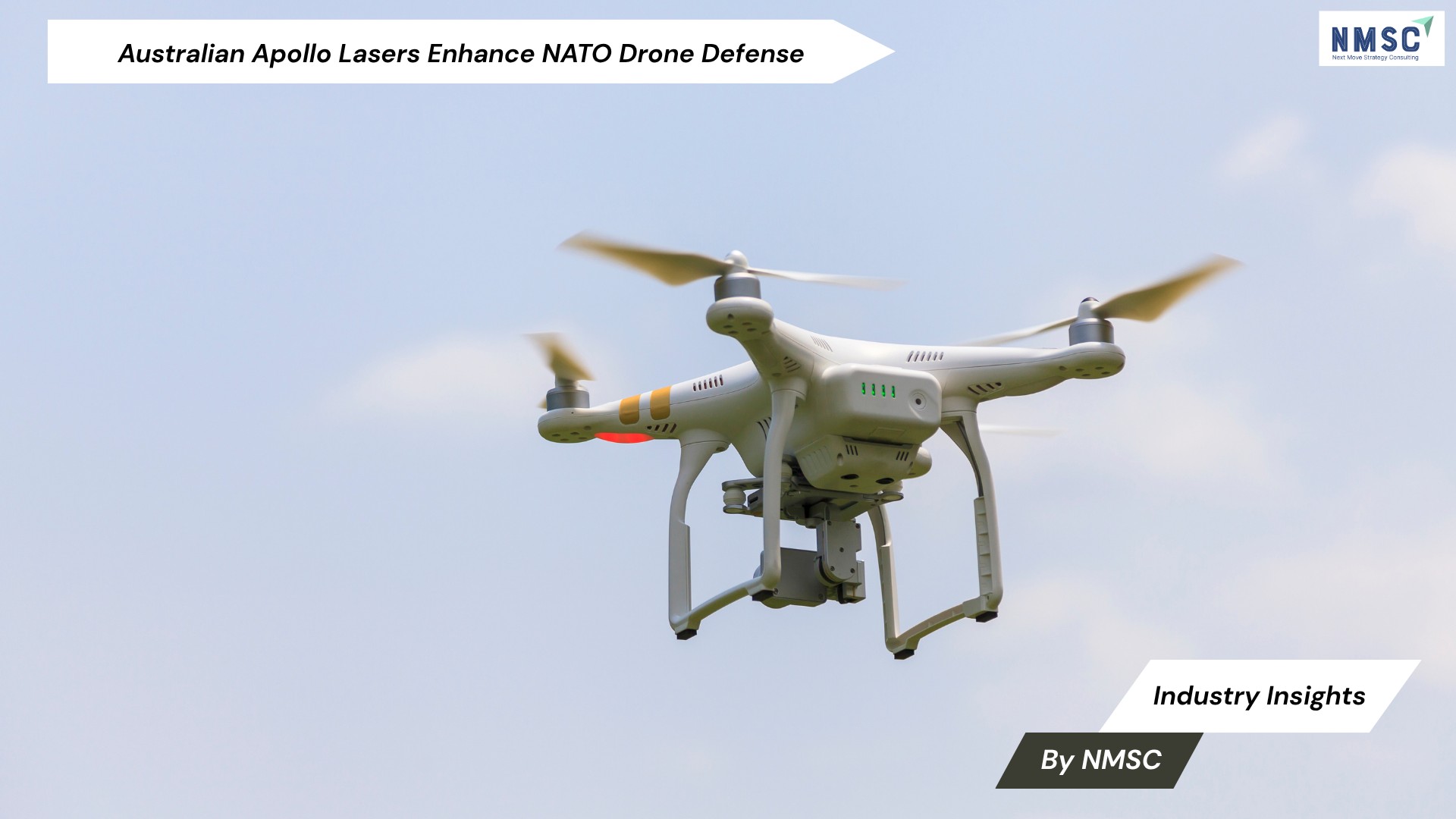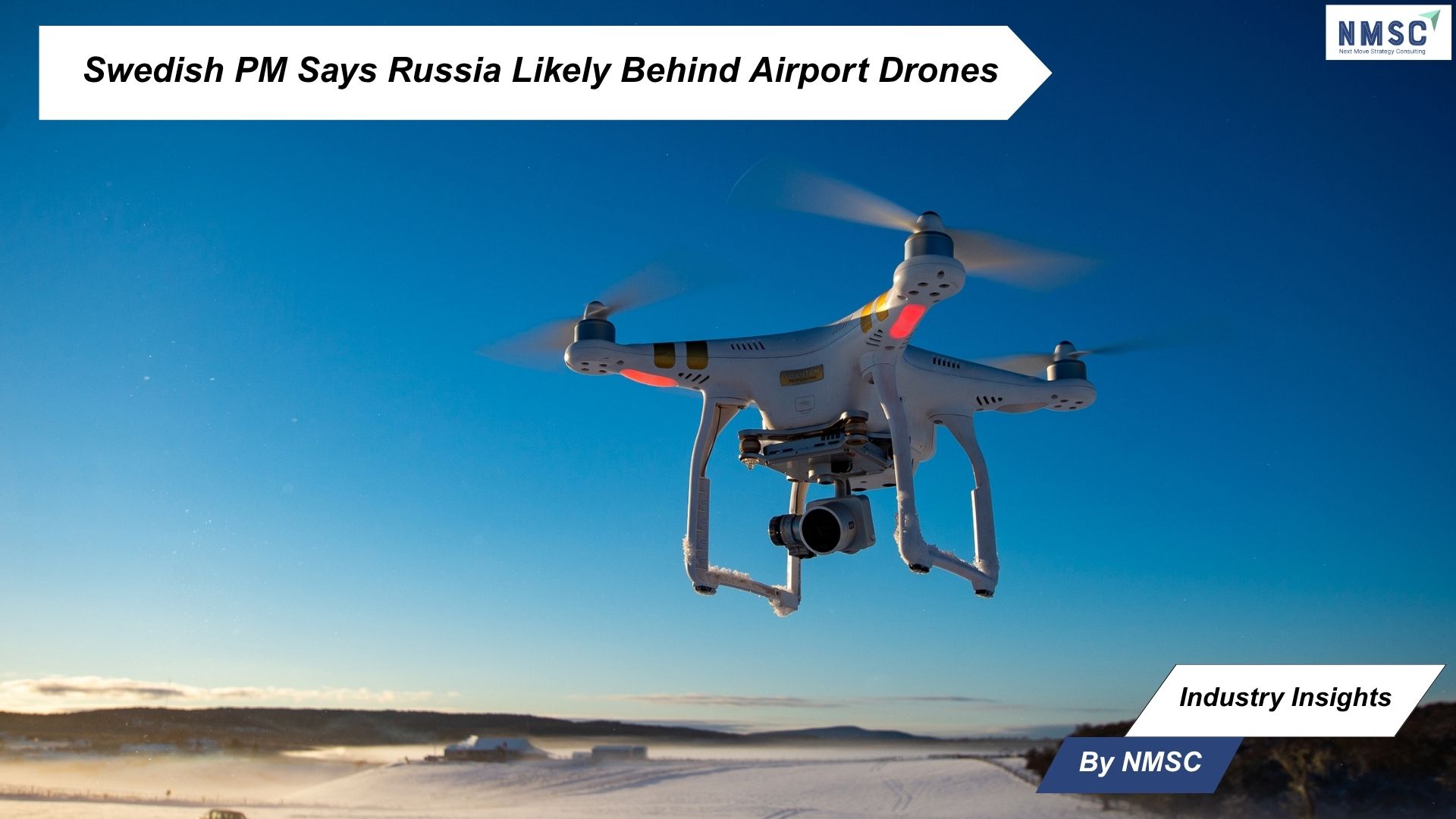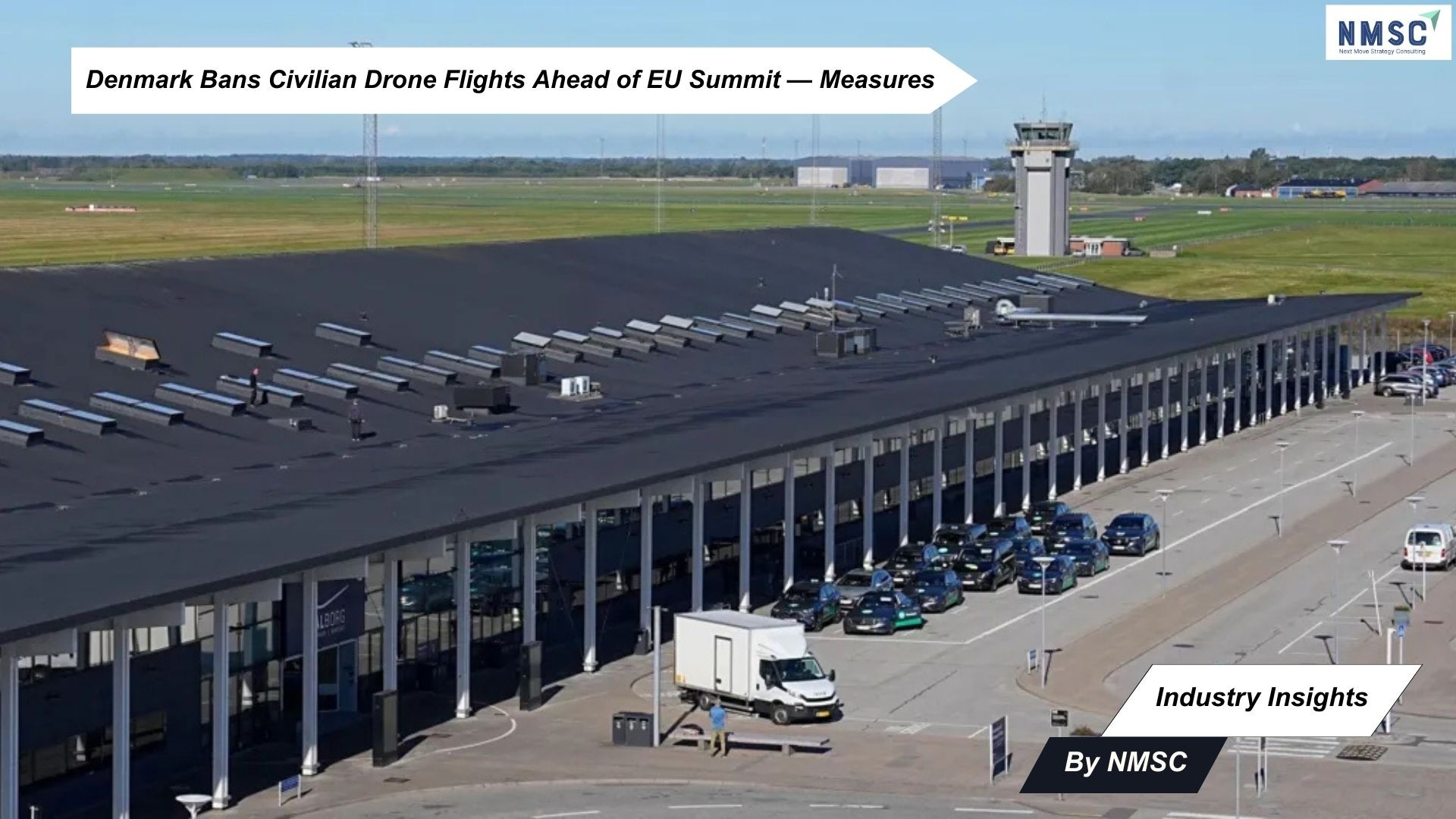Autonomous Black Hawk Becomes Battle Ready UAS Fast
Published: 2025-10-14

Industry Insight from Next Move Strategy Consulting
Sikorsky is redefining the iconic UH-60 Black Hawk for the next generation of warfare with the introduction of a cockpit-free variant designed for autonomous cargo missions.
The new model, called the S70-AS U-Hawk, replaces the traditional cockpit with clamshell doors, creating 25% more cargo capacity compared to the standard Black Hawk. Instead of a pilot, an operator using a tablet will set the flight plan, while an onboard computer—supported by advanced sensors, cameras, and algorithms—will handle the entire flight autonomously.
Sikorsky Unveils Autonomous U-Hawk at AUSA Conference
The demonstrator, converted from a former U.S. Army UH-60L, moved from concept to completion in just 10 months. Sikorsky is showcasing the aircraft at the Association of the U.S. Army’s annual conference in Washington, D.C., opening today.
“Sikorsky is pioneering a 21st-century solution by transforming UH-60L Black Hawks into fully autonomous utility platforms,” said Rich Benton, vice president and general manager at Sikorsky. “The U-Hawk builds on the Black Hawk’s legacy as the world’s leading utility aircraft and introduces new capabilities as an unmanned system.”
Sikorsky Expands Autonomous Portfolio with Nomad Drone Family
The announcement follows Sikorsky’s recent unveiling of its Nomad drone series — a new family of rotor-blown-wing aircraft powered by MATRIX autonomy technology.
The Nomad lineup spans multiple size classes, from Group 3 drones comparable to the Army’s retired RQ-7 Shadow to larger Group 4 and 5 variants similar to the MQ-1C Grey Eagle or even the Black Hawk. While still in prototype development, Sikorsky plans to accelerate scaling and production through the late 2020s.
U-Hawk Targets Heavy-Lift Gap in U.S. Military Logistics
Designed to carry nearly ten times the payload of Sikorsky’s Nomad drones, the U-Hawk addresses the rising demand for uncrewed heavy-lift and resupply capabilities in the U.S. military. Positioned between smaller unmanned systems like Nomad and large airlifters such as the C-130, the U-Hawk offers a practical, rapid-deployment alternative to new clean-sheet designs.
With the U.S. Army retiring more than 150 UH-60 helicopters, converting them into U-Hawks could give these aircraft a second life—bringing new meaning to “reduce, reuse, recycle.”
Impact on the Drone Market: A Transformational Shift
U-Hawk’s Entry Marks a New Phase in Defense-Grade Autonomy
The introduction of Sikorsky’s autonomous S70-AS U-Hawk represents a pivotal milestone in the global drone market, signaling a shift toward large-scale, heavy-lift unmanned aviation systems (UAS). Unlike traditional drones, which are often limited by payload capacity and range, the U-Hawk bridges the operational gap between lightweight tactical drones and full-size crewed aircraft. Its arrival is expected to bring both positive advancements and strategic market disruptions.
Positive Impacts: Strengthening the Drone Ecosystem
1. Expansion of the Heavy-Lift Drone Segment
-
The U-Hawk establishes a new benchmark for uncrewed cargo and resupply missions, addressing capability gaps left by smaller UAS.
-
It enables military and disaster-response agencies to transport heavier payloads without risking human pilots.
2. Acceleration of Autonomous Flight Adoption
-
By demonstrating full-scale autonomy in a proven airframe, Sikorsky validates AI-driven flight management systems for broader aviation use.
-
The integration of MATRIX autonomy and sensor fusion may accelerate adoption across both defense and commercial logistics.
3. Revitalization of Legacy Fleets
-
Repurposing retired UH-60L helicopters into U-Hawks exemplifies sustainable fleet modernization, reducing costs and extending aircraft life cycles.
-
This approach promotes a “retrofit revolution” in military aviation, encouraging other OEMs to upgrade rather than replace.
4. Boost to U.S. Defense Technology Leadership
-
The U-Hawk strengthens the U.S. position in next-generation military UAS innovation, countering global competition from China, Israel, and Europe.
-
It reinforces defense-industrial partnerships, aligning with Pentagon priorities for autonomous logistics and battlefield adaptability.
Potential Challenges and Market Concerns
While largely positive, the U-Hawk’s debut may also create market friction as defense budgets and suppliers adjust to the rapid technological evolution.
-
Market Displacement: Smaller UAS manufacturers may face reduced demand as large autonomous platforms take on missions once reserved for multiple smaller drones.
-
Regulatory Complexity: Full-scale autonomous flight introduces new airspace and certification challenges, potentially delaying widespread deployment.
-
Integration Costs: Upgrading legacy helicopters for autonomy may require significant software and systems investment, limiting near-term scalability.
Overall Market Outlook
The U-Hawk’s emergence is a net positive for the global drone and defense aviation markets. It signifies a turning point from small-scale experimentation to full-spectrum autonomy, paving the way for a new era of intelligent, pilotless aircraft capable of executing complex missions at scale.
As militaries and governments seek cost-effective and sustainable modernization paths, platforms like the U-Hawk will likely define the next decade of UAS innovation, merging proven platforms with cutting-edge autonomy to reshape the future of aerial logistics and defense operations.
Source: https://aerospaceglobalnews.com
Prepared By: Next Move Strategy Consulting
About the Author
 Karabi Sonowal is an accomplished SEO Executive and Content Writer with extensive expertise in digital marketing, SEO strategies, and audience engagement. She specializes in creating data-driven campaigns and impactful, audience-focused content that boosts visibility, drives traffic, and adds measurable value. With a strong focus on clarity and innovation, she combines strategic thinking with content creation to deliver meaningful digital experiences. Over the years, she has contributed to brand growth initiatives, driving lasting impact and engagement.
Karabi Sonowal is an accomplished SEO Executive and Content Writer with extensive expertise in digital marketing, SEO strategies, and audience engagement. She specializes in creating data-driven campaigns and impactful, audience-focused content that boosts visibility, drives traffic, and adds measurable value. With a strong focus on clarity and innovation, she combines strategic thinking with content creation to deliver meaningful digital experiences. Over the years, she has contributed to brand growth initiatives, driving lasting impact and engagement.
About the Reviewer
 Debashree Dey is a versatile Content Writer, PR Specialist, and Assistant Manager in Digital Marketing, known for her ability to craft audience-focused narratives and develop data-driven strategies that enhance brand visibility. As a published manuscript author, she combines creativity
with strategic acumen to help brands strengthen their presence and drive deeper user engagement. Outside of her professional pursuits, Debashree draws inspiration from creative projects and design explorations.
Debashree Dey is a versatile Content Writer, PR Specialist, and Assistant Manager in Digital Marketing, known for her ability to craft audience-focused narratives and develop data-driven strategies that enhance brand visibility. As a published manuscript author, she combines creativity
with strategic acumen to help brands strengthen their presence and drive deeper user engagement. Outside of her professional pursuits, Debashree draws inspiration from creative projects and design explorations.
















Add Comment